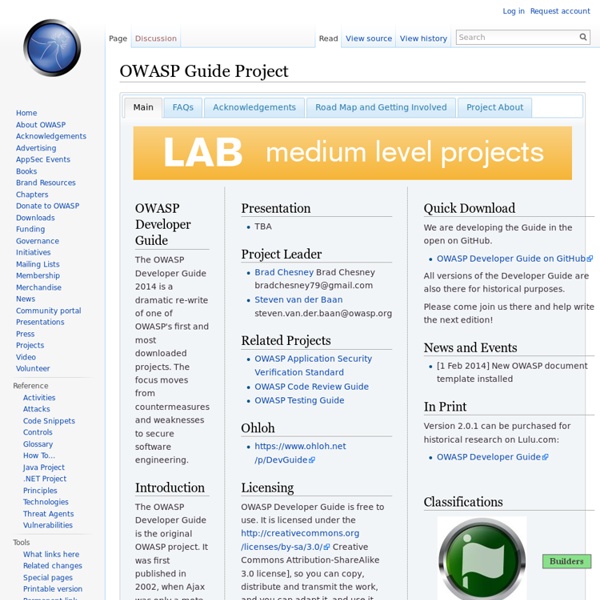OWASP Guide Project
OWASP Developer Guide The OWASP Developer Guide 2014 is a dramatic re-write of one of OWASP's first and most downloaded projects. The focus moves from countermeasures and weaknesses to secure software engineering. Introduction The OWASP Developer Guide is the original OWASP project. The Developer Guide 2014 is a "first principles" book - it's not specific to any one language or framework, as they all borrow ideas and syntax from each other. The major themes in the Developer Guide include: Foundation Architecture Design Build Configure Operate We are re-factoring the original material from the Developer Guide 2.0, released in July 2005, and bring it into the modern world, and focus it tightly on modern web apps that use Ajax and RESTful API, and of course, mobile applications. Intended audience The primary audience for the new version of the Developer Guide is Architects and Developers. Presentation Project Leader Related Projects Ohloh Licensing
Top 10 Android Hacking Apps and Tools Of 2015 for hackers and security researchers
Here’s the 10 best Android hacking apps and tools of 2015 With the rise of technology and advancements in the mobile field, hacking these days have become very common which was once thought to be done only by those who have an expert knowledge on computers. Even everyday things such as a smart device is hacked nowadays. Hacking apps are used by some people just to explore the world of technology or to override security measures that are installed on their mobile devices. As we are nearing towards the end of 2015, let’s have a look at the top 10 hacking apps of 2015 for android. 1. Hackode is one of the best applications for people who want to hack their android devices. 2. AndroRAT, short for Remote Administration Tool for Android, is a client/server application developed in Java Android for the client side and in Java/Swing for the Server, which is used to control a system without having physical access to the system. 3. SpoofApp is definitely used for fun over functionality. 4. 5. 6. 7.
Security Cheat Sheets for Ethical Hacking and Penetration Testing
4.6K Shares Share Tweet Email Security cheat sheets for Ethical Hacking and Penetration Testing by sniferl4bs. Download and Extract Command: wget master.zip Contents: aircrack-ngairportburpcewlcidrcookiesdigfierceftpgolismerohpinghttphttps-ssl-tlshydrajohnmaltegomarkdownmedusametasploitmsfvenommysqlncatnessusniktonmapnpingpermissionsphppivotingpspythonreverse-shellrubyshadowshodansqlmaptcpdumptsharkwebservervulnswireless-encryptionswiresharkwpHardening Download Cheatsheet: Security Cheat Sheets for Ethical Hacking and Penetration Testing
9 Best Hacking Apps For Android Phones | 2016
Based upon the industry reviews and our own experience, here is a compilation of the top Android hacking applications. Along with the description of apps, we have provided the relevant website and download links to help you get started instantly. Disclaimer: Please note that fossBytes is publishing this list just for educational purposes. We don’t support use of any tool to indulge in some unethical purposes. 9 Best Hacking Apps For Android Phones – 2016 AndroRAT AndroRAT stands for Android and RAT (Remote Administrative Tools). The features in this useful Android hacking app include collecting information like contacts, call logs, messages, and location. — AndroRAT Get FREE Video Training Course: Online Penetration Testing and Ethical Hacking Hackode Hackode is an Android app which is basically a collection of multiple tools for ethical hackers, IT specialists, and penetration testers. — Hackode zANTI zANTI is a reputed Android hacking suite from Zimperium. — zANTI FaceNiff — FaceNiff Droidsheep
Related:
Related:



